Strategic Human Resource Management: Carlsberg's Winning Behaviours Strategy
VerifiedAdded on 2023/03/30
|13
|2386
|255
AI Summary
This report analyzes Carlsberg's Winning Behaviours strategy and its alignment with strategic HR priorities. It also discusses the challenges faced during implementation and provides recommendations.
Contribute Materials
Your contribution can guide someone’s learning journey. Share your
documents today.
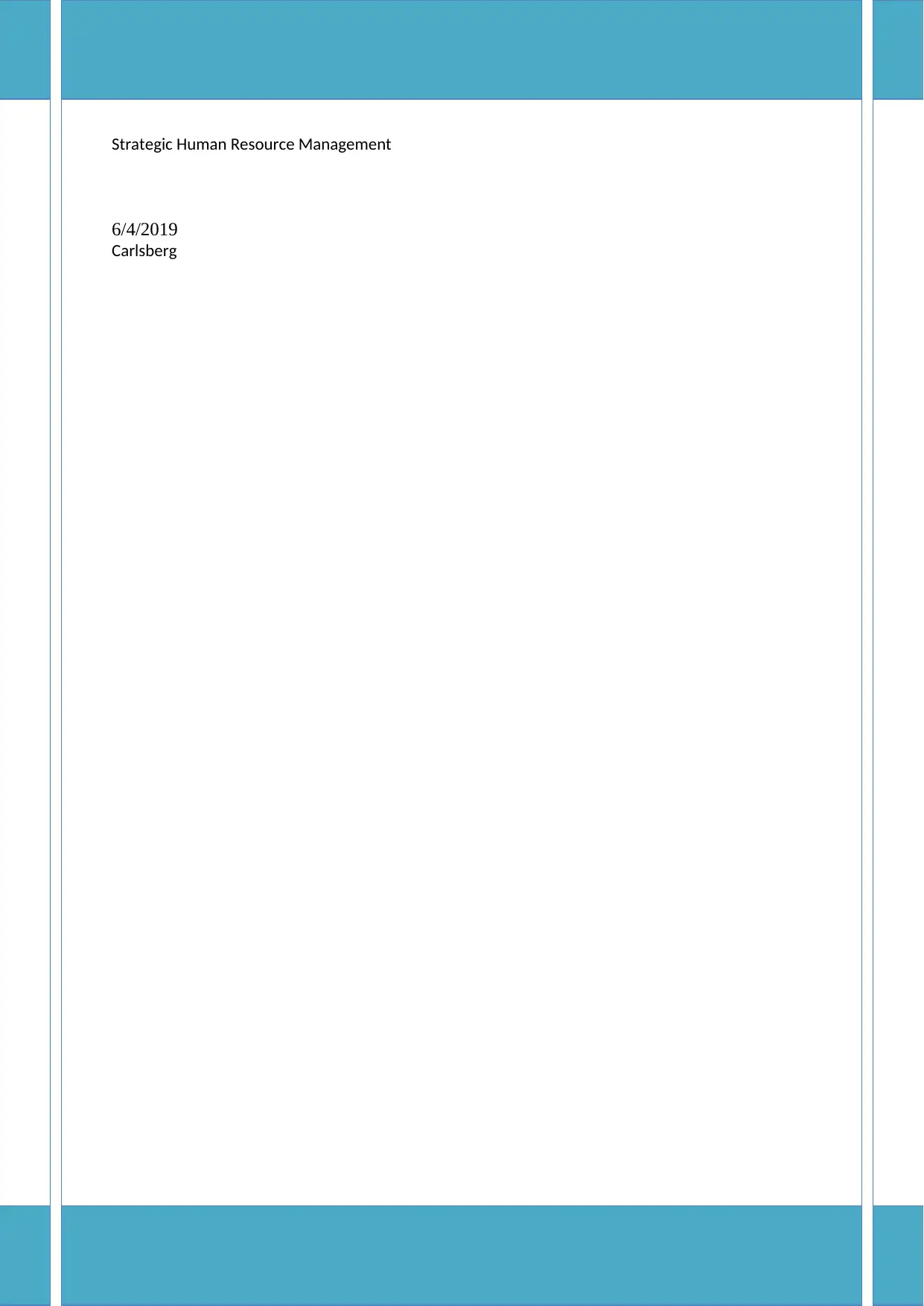
Strategic Human Resource Management
6/4/2019
Carlsberg
6/4/2019
Carlsberg
Secure Best Marks with AI Grader
Need help grading? Try our AI Grader for instant feedback on your assignments.

Contents
Introduction................................................................................................................................2
Overview of “Winning Behaviours” Strategy of Carlsberg.......................................................3
Strategic HR Priorities Pursued by Carlsberg............................................................................3
Rational of Implementing “Winning Behaviours” strategy...................................................4
Carlsberg's 'Winning Behaviours' strategy align with other HR practices.................................5
Social responsibility...............................................................................................................5
Workforce planning and development...................................................................................6
Difficulties Company faced when implementing this strategy in Malaysia..............................6
'Winning Behaviours' strategy in an Australian context............................................................7
Recommendations..................................................................................................................8
Conclusion..................................................................................................................................9
References................................................................................................................................10
Introduction................................................................................................................................2
Overview of “Winning Behaviours” Strategy of Carlsberg.......................................................3
Strategic HR Priorities Pursued by Carlsberg............................................................................3
Rational of Implementing “Winning Behaviours” strategy...................................................4
Carlsberg's 'Winning Behaviours' strategy align with other HR practices.................................5
Social responsibility...............................................................................................................5
Workforce planning and development...................................................................................6
Difficulties Company faced when implementing this strategy in Malaysia..............................6
'Winning Behaviours' strategy in an Australian context............................................................7
Recommendations..................................................................................................................8
Conclusion..................................................................................................................................9
References................................................................................................................................10
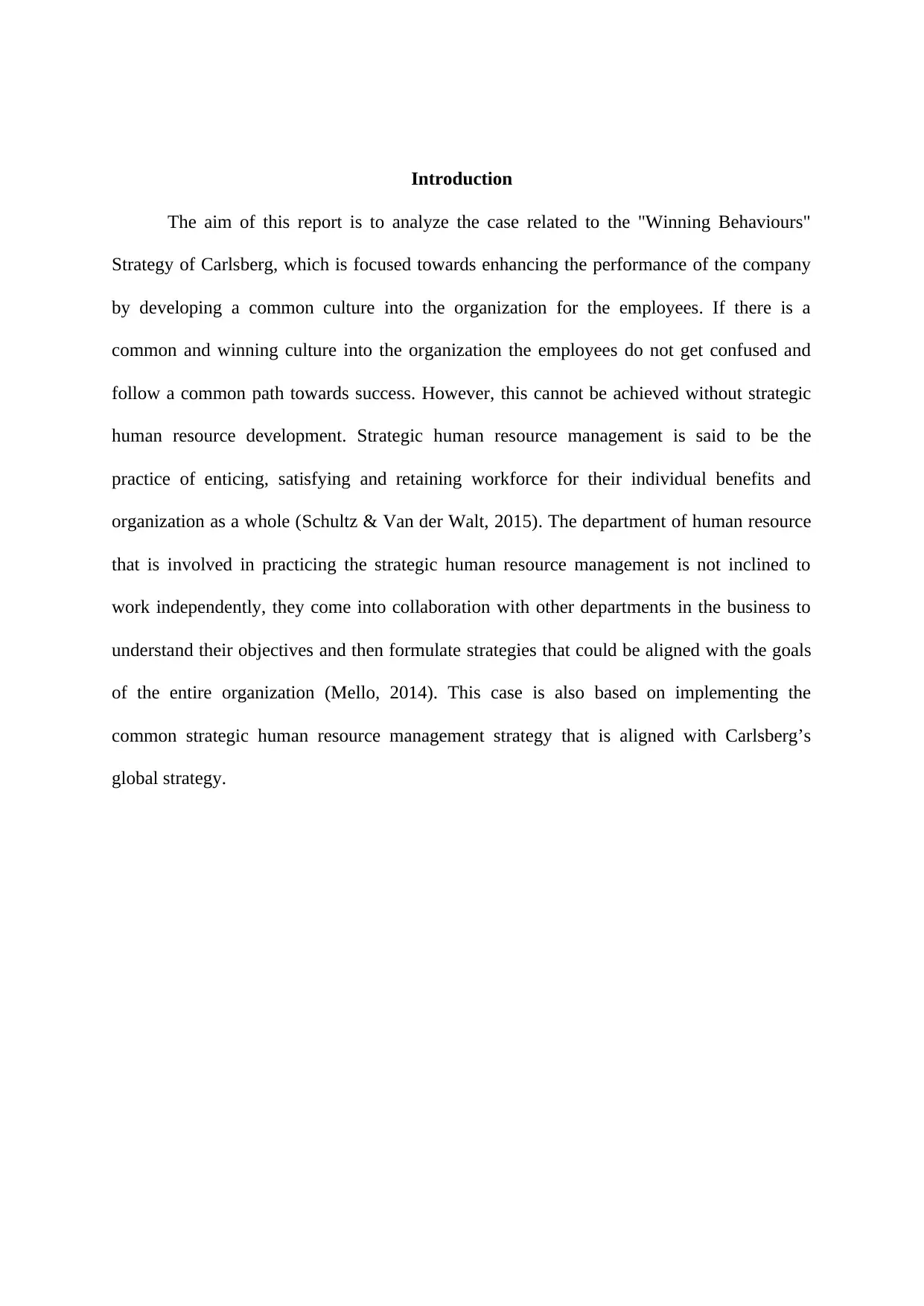
Introduction
The aim of this report is to analyze the case related to the "Winning Behaviours"
Strategy of Carlsberg, which is focused towards enhancing the performance of the company
by developing a common culture into the organization for the employees. If there is a
common and winning culture into the organization the employees do not get confused and
follow a common path towards success. However, this cannot be achieved without strategic
human resource development. Strategic human resource management is said to be the
practice of enticing, satisfying and retaining workforce for their individual benefits and
organization as a whole (Schultz & Van der Walt, 2015). The department of human resource
that is involved in practicing the strategic human resource management is not inclined to
work independently, they come into collaboration with other departments in the business to
understand their objectives and then formulate strategies that could be aligned with the goals
of the entire organization (Mello, 2014). This case is also based on implementing the
common strategic human resource management strategy that is aligned with Carlsberg’s
global strategy.
The aim of this report is to analyze the case related to the "Winning Behaviours"
Strategy of Carlsberg, which is focused towards enhancing the performance of the company
by developing a common culture into the organization for the employees. If there is a
common and winning culture into the organization the employees do not get confused and
follow a common path towards success. However, this cannot be achieved without strategic
human resource development. Strategic human resource management is said to be the
practice of enticing, satisfying and retaining workforce for their individual benefits and
organization as a whole (Schultz & Van der Walt, 2015). The department of human resource
that is involved in practicing the strategic human resource management is not inclined to
work independently, they come into collaboration with other departments in the business to
understand their objectives and then formulate strategies that could be aligned with the goals
of the entire organization (Mello, 2014). This case is also based on implementing the
common strategic human resource management strategy that is aligned with Carlsberg’s
global strategy.
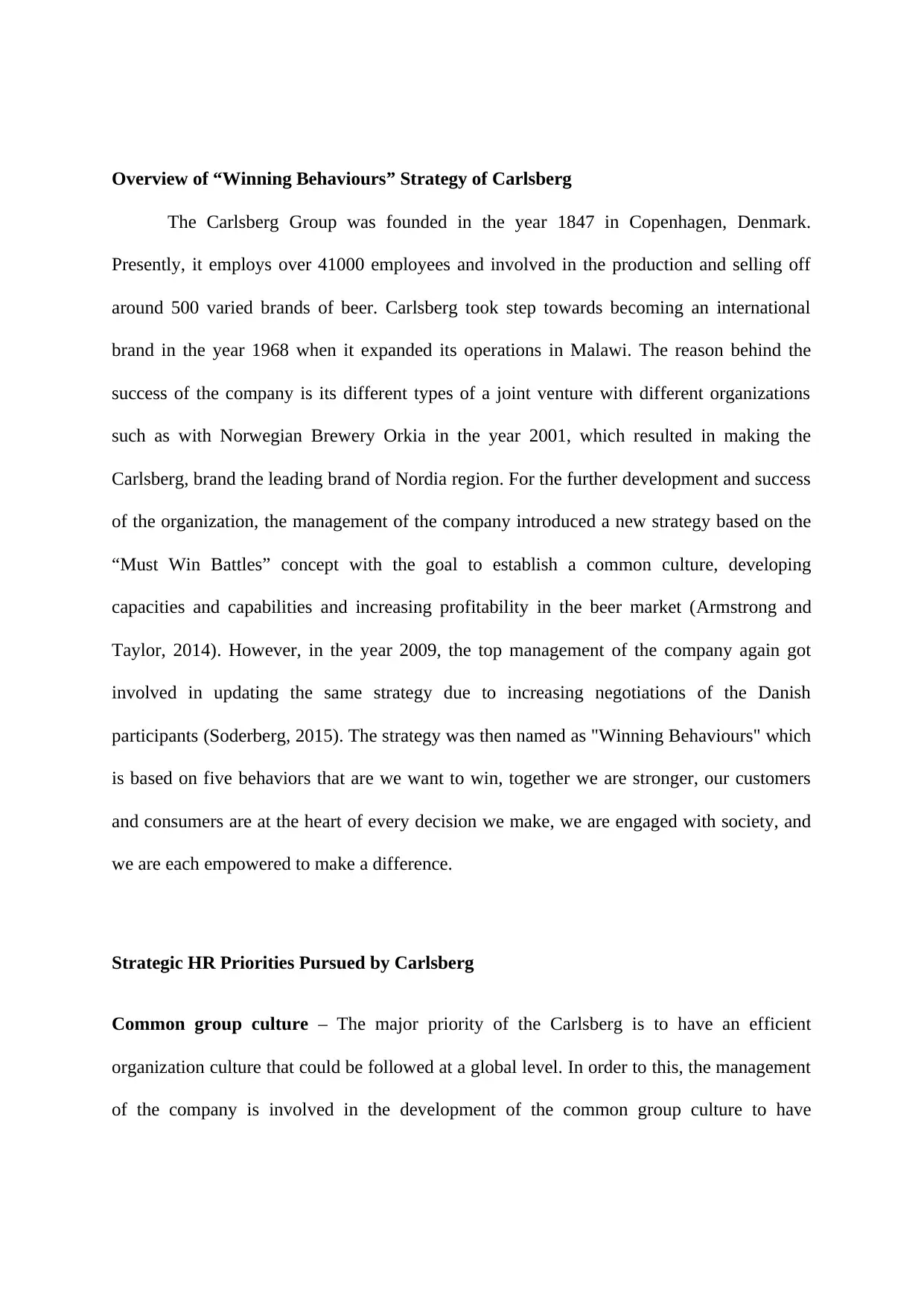
Overview of “Winning Behaviours” Strategy of Carlsberg
The Carlsberg Group was founded in the year 1847 in Copenhagen, Denmark.
Presently, it employs over 41000 employees and involved in the production and selling off
around 500 varied brands of beer. Carlsberg took step towards becoming an international
brand in the year 1968 when it expanded its operations in Malawi. The reason behind the
success of the company is its different types of a joint venture with different organizations
such as with Norwegian Brewery Orkia in the year 2001, which resulted in making the
Carlsberg, brand the leading brand of Nordia region. For the further development and success
of the organization, the management of the company introduced a new strategy based on the
“Must Win Battles” concept with the goal to establish a common culture, developing
capacities and capabilities and increasing profitability in the beer market (Armstrong and
Taylor, 2014). However, in the year 2009, the top management of the company again got
involved in updating the same strategy due to increasing negotiations of the Danish
participants (Soderberg, 2015). The strategy was then named as "Winning Behaviours" which
is based on five behaviors that are we want to win, together we are stronger, our customers
and consumers are at the heart of every decision we make, we are engaged with society, and
we are each empowered to make a difference.
Strategic HR Priorities Pursued by Carlsberg
Common group culture – The major priority of the Carlsberg is to have an efficient
organization culture that could be followed at a global level. In order to this, the management
of the company is involved in the development of the common group culture to have
The Carlsberg Group was founded in the year 1847 in Copenhagen, Denmark.
Presently, it employs over 41000 employees and involved in the production and selling off
around 500 varied brands of beer. Carlsberg took step towards becoming an international
brand in the year 1968 when it expanded its operations in Malawi. The reason behind the
success of the company is its different types of a joint venture with different organizations
such as with Norwegian Brewery Orkia in the year 2001, which resulted in making the
Carlsberg, brand the leading brand of Nordia region. For the further development and success
of the organization, the management of the company introduced a new strategy based on the
“Must Win Battles” concept with the goal to establish a common culture, developing
capacities and capabilities and increasing profitability in the beer market (Armstrong and
Taylor, 2014). However, in the year 2009, the top management of the company again got
involved in updating the same strategy due to increasing negotiations of the Danish
participants (Soderberg, 2015). The strategy was then named as "Winning Behaviours" which
is based on five behaviors that are we want to win, together we are stronger, our customers
and consumers are at the heart of every decision we make, we are engaged with society, and
we are each empowered to make a difference.
Strategic HR Priorities Pursued by Carlsberg
Common group culture – The major priority of the Carlsberg is to have an efficient
organization culture that could be followed at a global level. In order to this, the management
of the company is involved in the development of the common group culture to have
Secure Best Marks with AI Grader
Need help grading? Try our AI Grader for instant feedback on your assignments.
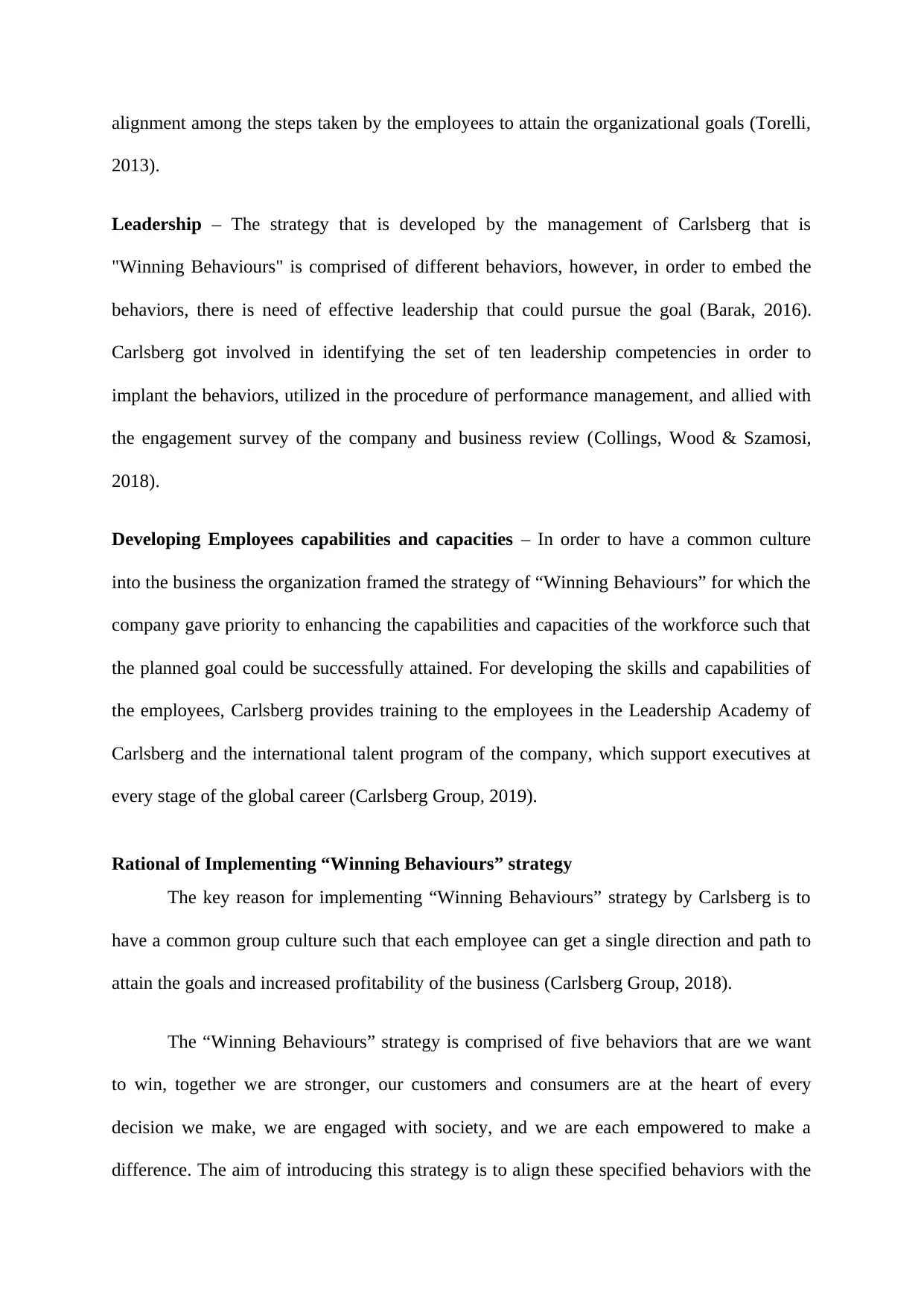
alignment among the steps taken by the employees to attain the organizational goals (Torelli,
2013).
Leadership – The strategy that is developed by the management of Carlsberg that is
"Winning Behaviours" is comprised of different behaviors, however, in order to embed the
behaviors, there is need of effective leadership that could pursue the goal (Barak, 2016).
Carlsberg got involved in identifying the set of ten leadership competencies in order to
implant the behaviors, utilized in the procedure of performance management, and allied with
the engagement survey of the company and business review (Collings, Wood & Szamosi,
2018).
Developing Employees capabilities and capacities – In order to have a common culture
into the business the organization framed the strategy of “Winning Behaviours” for which the
company gave priority to enhancing the capabilities and capacities of the workforce such that
the planned goal could be successfully attained. For developing the skills and capabilities of
the employees, Carlsberg provides training to the employees in the Leadership Academy of
Carlsberg and the international talent program of the company, which support executives at
every stage of the global career (Carlsberg Group, 2019).
Rational of Implementing “Winning Behaviours” strategy
The key reason for implementing “Winning Behaviours” strategy by Carlsberg is to
have a common group culture such that each employee can get a single direction and path to
attain the goals and increased profitability of the business (Carlsberg Group, 2018).
The “Winning Behaviours” strategy is comprised of five behaviors that are we want
to win, together we are stronger, our customers and consumers are at the heart of every
decision we make, we are engaged with society, and we are each empowered to make a
difference. The aim of introducing this strategy is to align these specified behaviors with the
2013).
Leadership – The strategy that is developed by the management of Carlsberg that is
"Winning Behaviours" is comprised of different behaviors, however, in order to embed the
behaviors, there is need of effective leadership that could pursue the goal (Barak, 2016).
Carlsberg got involved in identifying the set of ten leadership competencies in order to
implant the behaviors, utilized in the procedure of performance management, and allied with
the engagement survey of the company and business review (Collings, Wood & Szamosi,
2018).
Developing Employees capabilities and capacities – In order to have a common culture
into the business the organization framed the strategy of “Winning Behaviours” for which the
company gave priority to enhancing the capabilities and capacities of the workforce such that
the planned goal could be successfully attained. For developing the skills and capabilities of
the employees, Carlsberg provides training to the employees in the Leadership Academy of
Carlsberg and the international talent program of the company, which support executives at
every stage of the global career (Carlsberg Group, 2019).
Rational of Implementing “Winning Behaviours” strategy
The key reason for implementing “Winning Behaviours” strategy by Carlsberg is to
have a common group culture such that each employee can get a single direction and path to
attain the goals and increased profitability of the business (Carlsberg Group, 2018).
The “Winning Behaviours” strategy is comprised of five behaviors that are we want
to win, together we are stronger, our customers and consumers are at the heart of every
decision we make, we are engaged with society, and we are each empowered to make a
difference. The aim of introducing this strategy is to align these specified behaviors with the
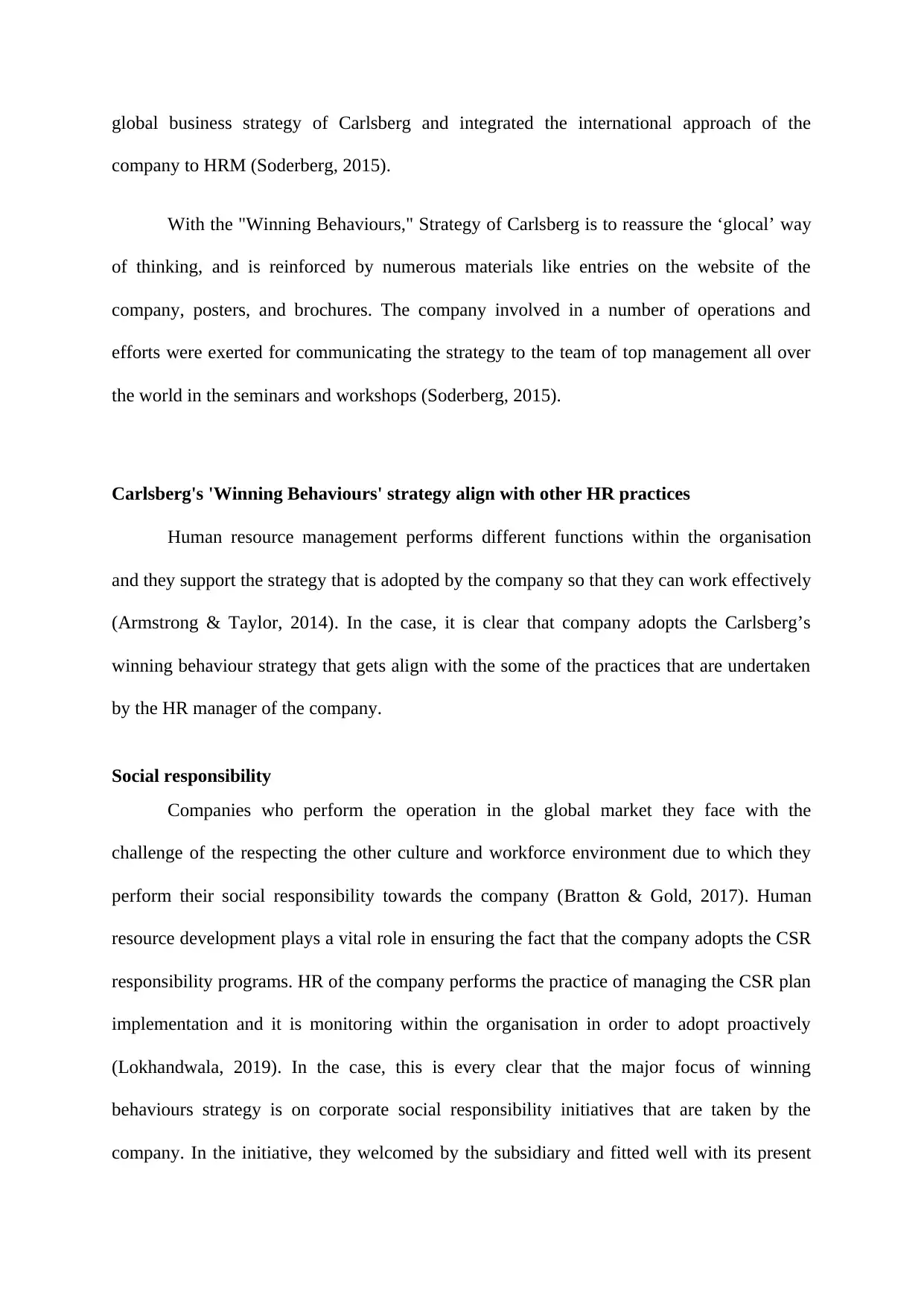
global business strategy of Carlsberg and integrated the international approach of the
company to HRM (Soderberg, 2015).
With the "Winning Behaviours," Strategy of Carlsberg is to reassure the ‘glocal’ way
of thinking, and is reinforced by numerous materials like entries on the website of the
company, posters, and brochures. The company involved in a number of operations and
efforts were exerted for communicating the strategy to the team of top management all over
the world in the seminars and workshops (Soderberg, 2015).
Carlsberg's 'Winning Behaviours' strategy align with other HR practices
Human resource management performs different functions within the organisation
and they support the strategy that is adopted by the company so that they can work effectively
(Armstrong & Taylor, 2014). In the case, it is clear that company adopts the Carlsberg’s
winning behaviour strategy that gets align with the some of the practices that are undertaken
by the HR manager of the company.
Social responsibility
Companies who perform the operation in the global market they face with the
challenge of the respecting the other culture and workforce environment due to which they
perform their social responsibility towards the company (Bratton & Gold, 2017). Human
resource development plays a vital role in ensuring the fact that the company adopts the CSR
responsibility programs. HR of the company performs the practice of managing the CSR plan
implementation and it is monitoring within the organisation in order to adopt proactively
(Lokhandwala, 2019). In the case, this is every clear that the major focus of winning
behaviours strategy is on corporate social responsibility initiatives that are taken by the
company. In the initiative, they welcomed by the subsidiary and fitted well with its present
company to HRM (Soderberg, 2015).
With the "Winning Behaviours," Strategy of Carlsberg is to reassure the ‘glocal’ way
of thinking, and is reinforced by numerous materials like entries on the website of the
company, posters, and brochures. The company involved in a number of operations and
efforts were exerted for communicating the strategy to the team of top management all over
the world in the seminars and workshops (Soderberg, 2015).
Carlsberg's 'Winning Behaviours' strategy align with other HR practices
Human resource management performs different functions within the organisation
and they support the strategy that is adopted by the company so that they can work effectively
(Armstrong & Taylor, 2014). In the case, it is clear that company adopts the Carlsberg’s
winning behaviour strategy that gets align with the some of the practices that are undertaken
by the HR manager of the company.
Social responsibility
Companies who perform the operation in the global market they face with the
challenge of the respecting the other culture and workforce environment due to which they
perform their social responsibility towards the company (Bratton & Gold, 2017). Human
resource development plays a vital role in ensuring the fact that the company adopts the CSR
responsibility programs. HR of the company performs the practice of managing the CSR plan
implementation and it is monitoring within the organisation in order to adopt proactively
(Lokhandwala, 2019). In the case, this is every clear that the major focus of winning
behaviours strategy is on corporate social responsibility initiatives that are taken by the
company. In the initiative, they welcomed by the subsidiary and fitted well with its present
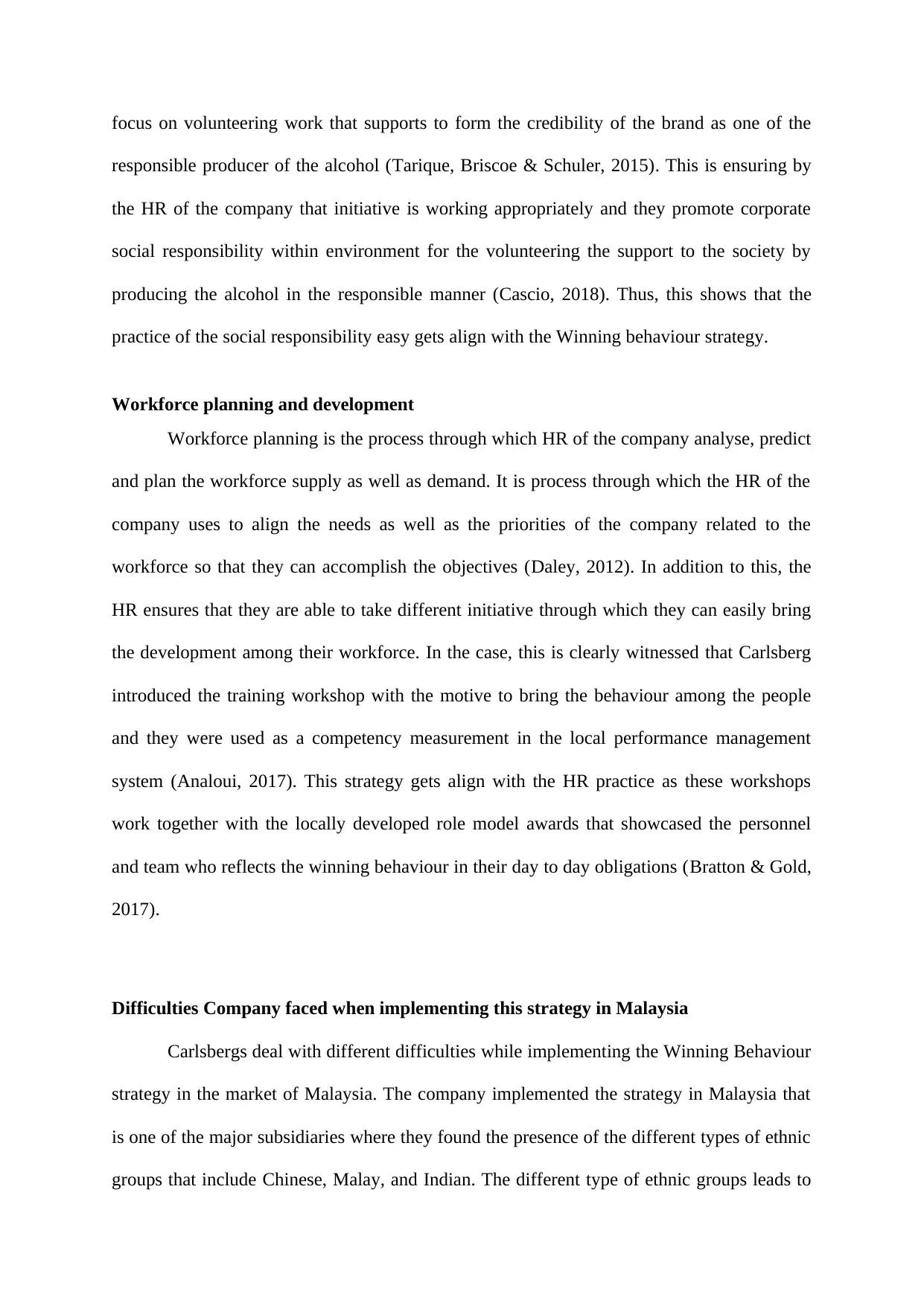
focus on volunteering work that supports to form the credibility of the brand as one of the
responsible producer of the alcohol (Tarique, Briscoe & Schuler, 2015). This is ensuring by
the HR of the company that initiative is working appropriately and they promote corporate
social responsibility within environment for the volunteering the support to the society by
producing the alcohol in the responsible manner (Cascio, 2018). Thus, this shows that the
practice of the social responsibility easy gets align with the Winning behaviour strategy.
Workforce planning and development
Workforce planning is the process through which HR of the company analyse, predict
and plan the workforce supply as well as demand. It is process through which the HR of the
company uses to align the needs as well as the priorities of the company related to the
workforce so that they can accomplish the objectives (Daley, 2012). In addition to this, the
HR ensures that they are able to take different initiative through which they can easily bring
the development among their workforce. In the case, this is clearly witnessed that Carlsberg
introduced the training workshop with the motive to bring the behaviour among the people
and they were used as a competency measurement in the local performance management
system (Analoui, 2017). This strategy gets align with the HR practice as these workshops
work together with the locally developed role model awards that showcased the personnel
and team who reflects the winning behaviour in their day to day obligations (Bratton & Gold,
2017).
Difficulties Company faced when implementing this strategy in Malaysia
Carlsbergs deal with different difficulties while implementing the Winning Behaviour
strategy in the market of Malaysia. The company implemented the strategy in Malaysia that
is one of the major subsidiaries where they found the presence of the different types of ethnic
groups that include Chinese, Malay, and Indian. The different type of ethnic groups leads to
responsible producer of the alcohol (Tarique, Briscoe & Schuler, 2015). This is ensuring by
the HR of the company that initiative is working appropriately and they promote corporate
social responsibility within environment for the volunteering the support to the society by
producing the alcohol in the responsible manner (Cascio, 2018). Thus, this shows that the
practice of the social responsibility easy gets align with the Winning behaviour strategy.
Workforce planning and development
Workforce planning is the process through which HR of the company analyse, predict
and plan the workforce supply as well as demand. It is process through which the HR of the
company uses to align the needs as well as the priorities of the company related to the
workforce so that they can accomplish the objectives (Daley, 2012). In addition to this, the
HR ensures that they are able to take different initiative through which they can easily bring
the development among their workforce. In the case, this is clearly witnessed that Carlsberg
introduced the training workshop with the motive to bring the behaviour among the people
and they were used as a competency measurement in the local performance management
system (Analoui, 2017). This strategy gets align with the HR practice as these workshops
work together with the locally developed role model awards that showcased the personnel
and team who reflects the winning behaviour in their day to day obligations (Bratton & Gold,
2017).
Difficulties Company faced when implementing this strategy in Malaysia
Carlsbergs deal with different difficulties while implementing the Winning Behaviour
strategy in the market of Malaysia. The company implemented the strategy in Malaysia that
is one of the major subsidiaries where they found the presence of the different types of ethnic
groups that include Chinese, Malay, and Indian. The different type of ethnic groups leads to
Paraphrase This Document
Need a fresh take? Get an instant paraphrase of this document with our AI Paraphraser
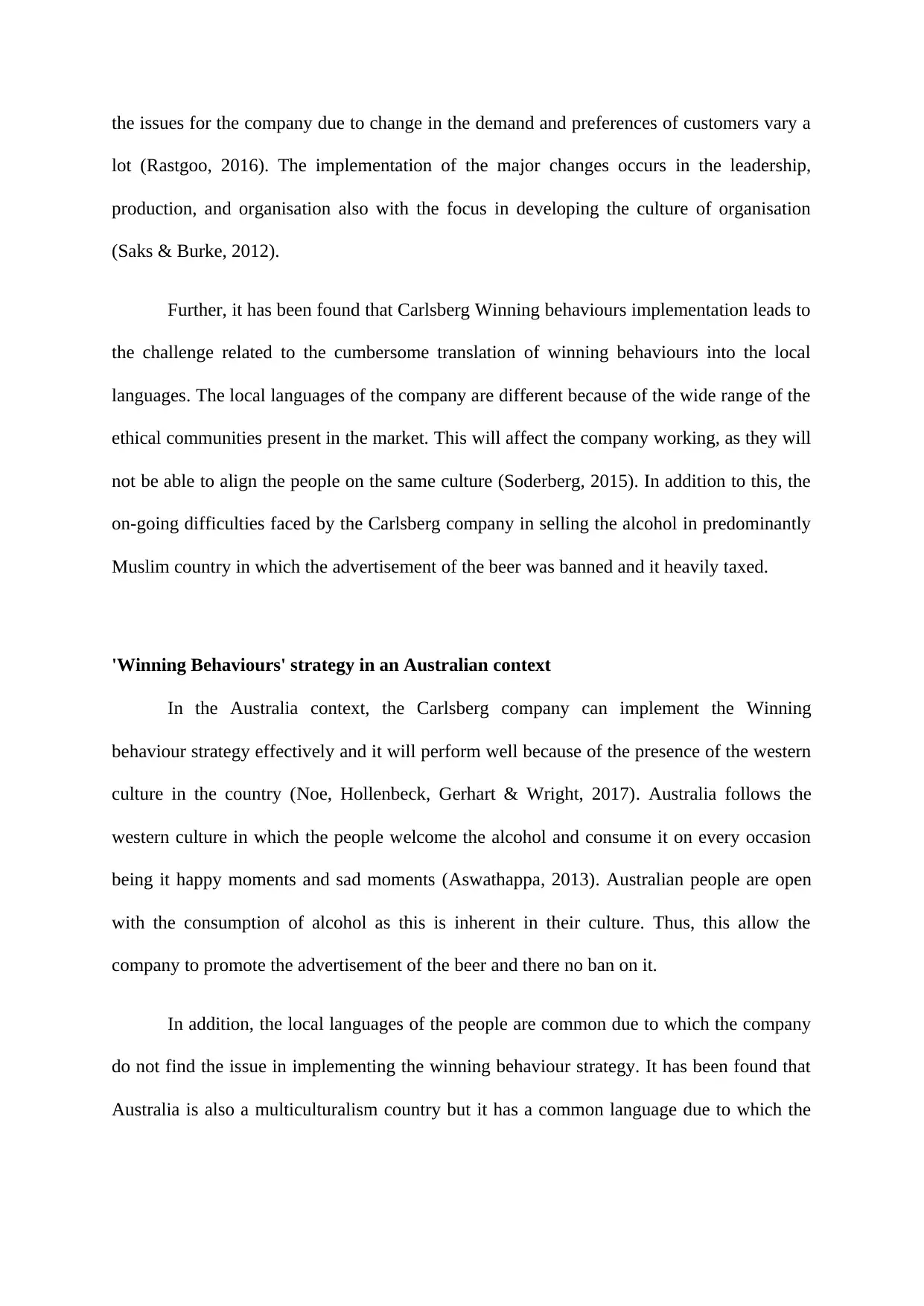
the issues for the company due to change in the demand and preferences of customers vary a
lot (Rastgoo, 2016). The implementation of the major changes occurs in the leadership,
production, and organisation also with the focus in developing the culture of organisation
(Saks & Burke, 2012).
Further, it has been found that Carlsberg Winning behaviours implementation leads to
the challenge related to the cumbersome translation of winning behaviours into the local
languages. The local languages of the company are different because of the wide range of the
ethical communities present in the market. This will affect the company working, as they will
not be able to align the people on the same culture (Soderberg, 2015). In addition to this, the
on-going difficulties faced by the Carlsberg company in selling the alcohol in predominantly
Muslim country in which the advertisement of the beer was banned and it heavily taxed.
'Winning Behaviours' strategy in an Australian context
In the Australia context, the Carlsberg company can implement the Winning
behaviour strategy effectively and it will perform well because of the presence of the western
culture in the country (Noe, Hollenbeck, Gerhart & Wright, 2017). Australia follows the
western culture in which the people welcome the alcohol and consume it on every occasion
being it happy moments and sad moments (Aswathappa, 2013). Australian people are open
with the consumption of alcohol as this is inherent in their culture. Thus, this allow the
company to promote the advertisement of the beer and there no ban on it.
In addition, the local languages of the people are common due to which the company
do not find the issue in implementing the winning behaviour strategy. It has been found that
Australia is also a multiculturalism country but it has a common language due to which the
lot (Rastgoo, 2016). The implementation of the major changes occurs in the leadership,
production, and organisation also with the focus in developing the culture of organisation
(Saks & Burke, 2012).
Further, it has been found that Carlsberg Winning behaviours implementation leads to
the challenge related to the cumbersome translation of winning behaviours into the local
languages. The local languages of the company are different because of the wide range of the
ethical communities present in the market. This will affect the company working, as they will
not be able to align the people on the same culture (Soderberg, 2015). In addition to this, the
on-going difficulties faced by the Carlsberg company in selling the alcohol in predominantly
Muslim country in which the advertisement of the beer was banned and it heavily taxed.
'Winning Behaviours' strategy in an Australian context
In the Australia context, the Carlsberg company can implement the Winning
behaviour strategy effectively and it will perform well because of the presence of the western
culture in the country (Noe, Hollenbeck, Gerhart & Wright, 2017). Australia follows the
western culture in which the people welcome the alcohol and consume it on every occasion
being it happy moments and sad moments (Aswathappa, 2013). Australian people are open
with the consumption of alcohol as this is inherent in their culture. Thus, this allow the
company to promote the advertisement of the beer and there no ban on it.
In addition, the local languages of the people are common due to which the company
do not find the issue in implementing the winning behaviour strategy. It has been found that
Australia is also a multiculturalism country but it has a common language due to which the
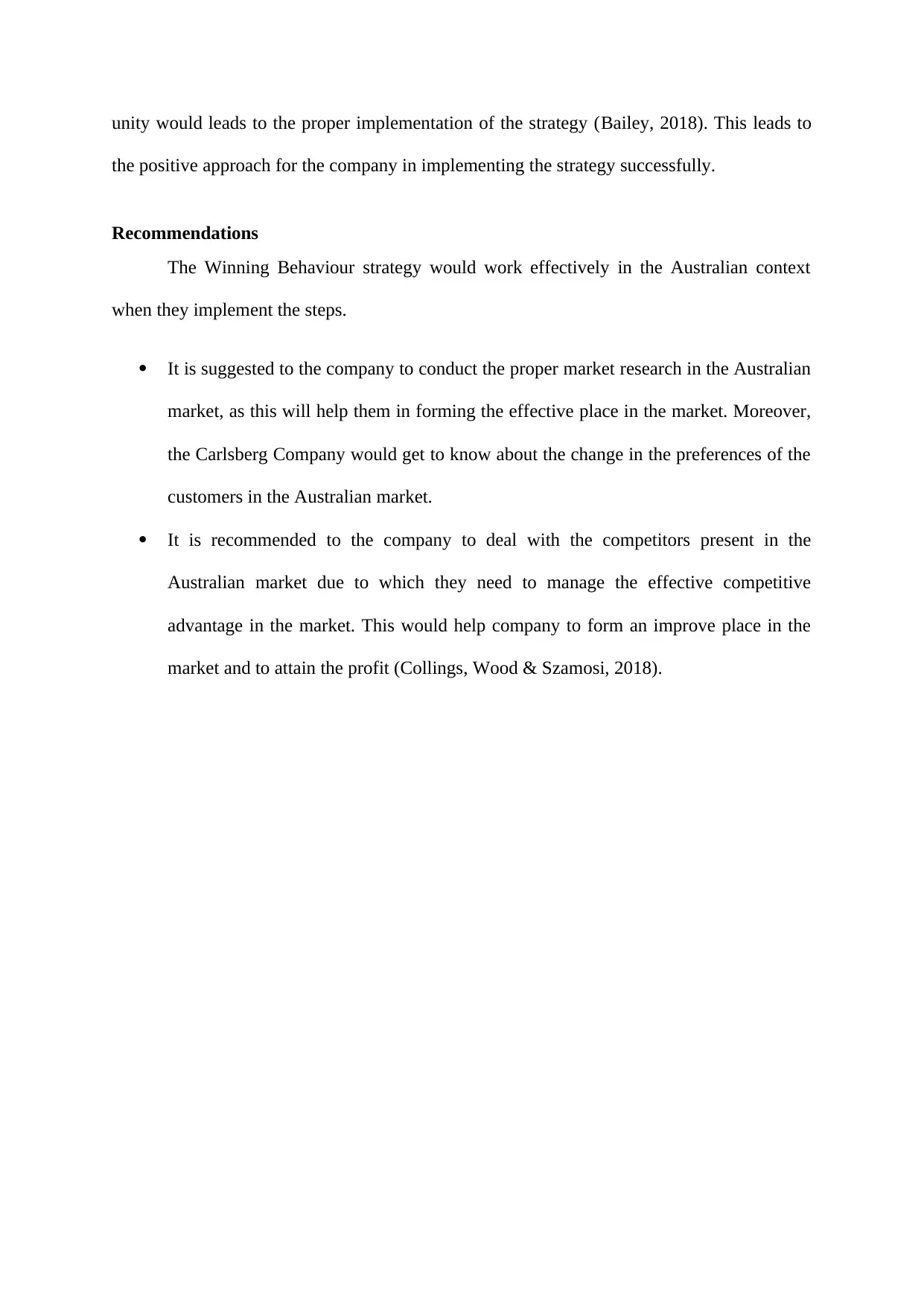
unity would leads to the proper implementation of the strategy (Bailey, 2018). This leads to
the positive approach for the company in implementing the strategy successfully.
Recommendations
The Winning Behaviour strategy would work effectively in the Australian context
when they implement the steps.
It is suggested to the company to conduct the proper market research in the Australian
market, as this will help them in forming the effective place in the market. Moreover,
the Carlsberg Company would get to know about the change in the preferences of the
customers in the Australian market.
It is recommended to the company to deal with the competitors present in the
Australian market due to which they need to manage the effective competitive
advantage in the market. This would help company to form an improve place in the
market and to attain the profit (Collings, Wood & Szamosi, 2018).
the positive approach for the company in implementing the strategy successfully.
Recommendations
The Winning Behaviour strategy would work effectively in the Australian context
when they implement the steps.
It is suggested to the company to conduct the proper market research in the Australian
market, as this will help them in forming the effective place in the market. Moreover,
the Carlsberg Company would get to know about the change in the preferences of the
customers in the Australian market.
It is recommended to the company to deal with the competitors present in the
Australian market due to which they need to manage the effective competitive
advantage in the market. This would help company to form an improve place in the
market and to attain the profit (Collings, Wood & Szamosi, 2018).
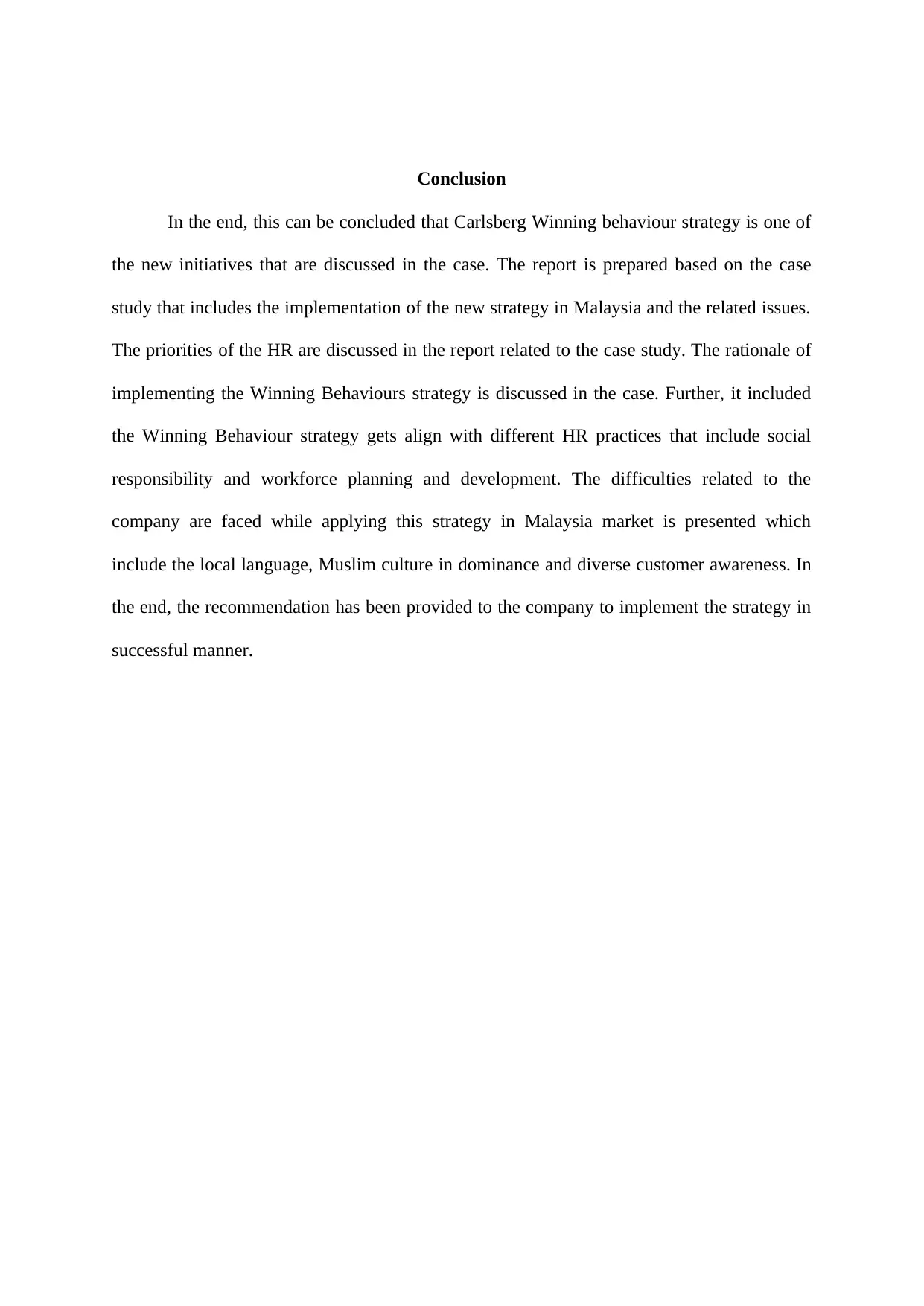
Conclusion
In the end, this can be concluded that Carlsberg Winning behaviour strategy is one of
the new initiatives that are discussed in the case. The report is prepared based on the case
study that includes the implementation of the new strategy in Malaysia and the related issues.
The priorities of the HR are discussed in the report related to the case study. The rationale of
implementing the Winning Behaviours strategy is discussed in the case. Further, it included
the Winning Behaviour strategy gets align with different HR practices that include social
responsibility and workforce planning and development. The difficulties related to the
company are faced while applying this strategy in Malaysia market is presented which
include the local language, Muslim culture in dominance and diverse customer awareness. In
the end, the recommendation has been provided to the company to implement the strategy in
successful manner.
In the end, this can be concluded that Carlsberg Winning behaviour strategy is one of
the new initiatives that are discussed in the case. The report is prepared based on the case
study that includes the implementation of the new strategy in Malaysia and the related issues.
The priorities of the HR are discussed in the report related to the case study. The rationale of
implementing the Winning Behaviours strategy is discussed in the case. Further, it included
the Winning Behaviour strategy gets align with different HR practices that include social
responsibility and workforce planning and development. The difficulties related to the
company are faced while applying this strategy in Malaysia market is presented which
include the local language, Muslim culture in dominance and diverse customer awareness. In
the end, the recommendation has been provided to the company to implement the strategy in
successful manner.
Secure Best Marks with AI Grader
Need help grading? Try our AI Grader for instant feedback on your assignments.
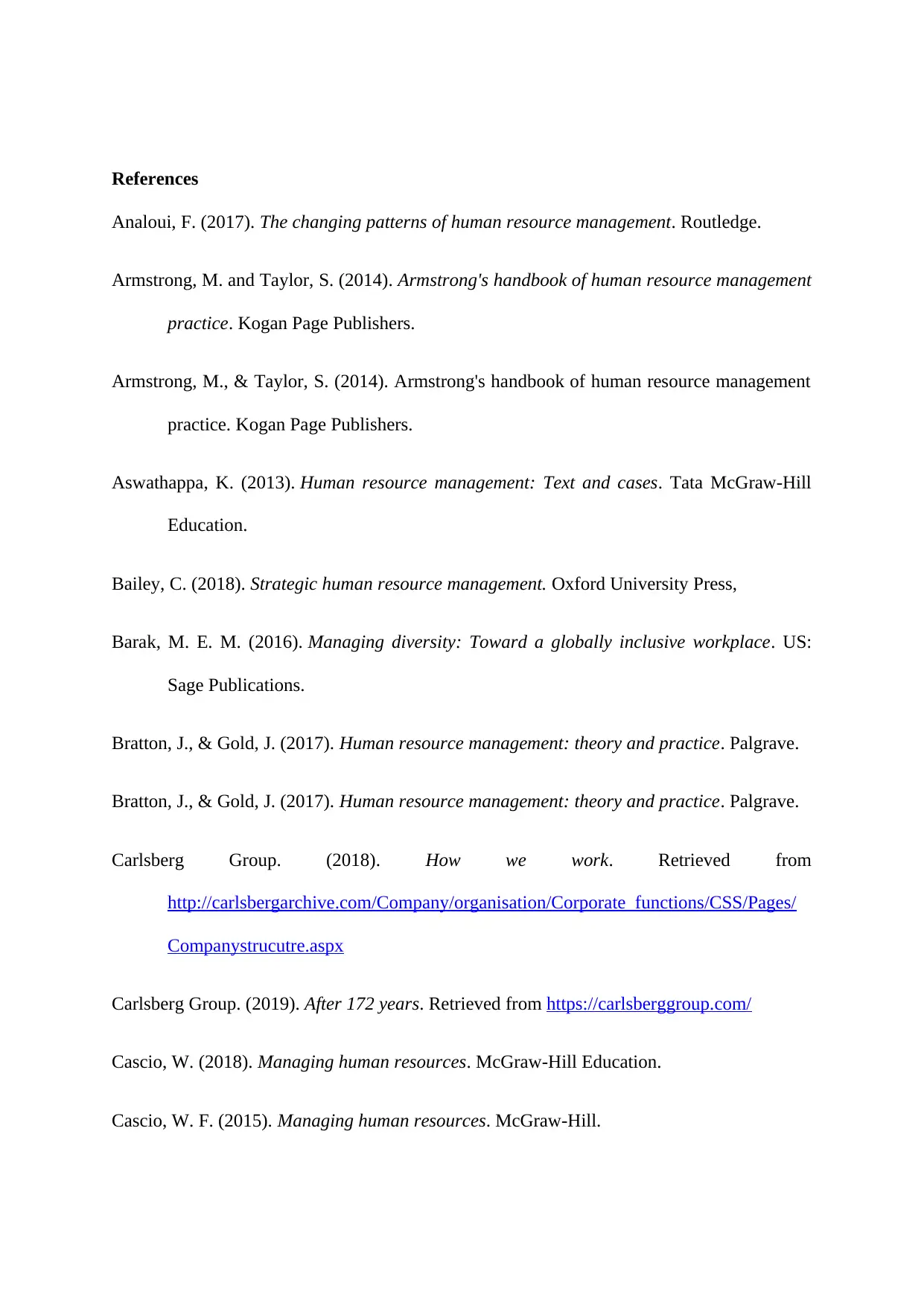
References
Analoui, F. (2017). The changing patterns of human resource management. Routledge.
Armstrong, M. and Taylor, S. (2014). Armstrong's handbook of human resource management
practice. Kogan Page Publishers.
Armstrong, M., & Taylor, S. (2014). Armstrong's handbook of human resource management
practice. Kogan Page Publishers.
Aswathappa, K. (2013). Human resource management: Text and cases. Tata McGraw-Hill
Education.
Bailey, C. (2018). Strategic human resource management. Oxford University Press,
Barak, M. E. M. (2016). Managing diversity: Toward a globally inclusive workplace. US:
Sage Publications.
Bratton, J., & Gold, J. (2017). Human resource management: theory and practice. Palgrave.
Bratton, J., & Gold, J. (2017). Human resource management: theory and practice. Palgrave.
Carlsberg Group. (2018). How we work. Retrieved from
http://carlsbergarchive.com/Company/organisation/Corporate_functions/CSS/Pages/
Companystrucutre.aspx
Carlsberg Group. (2019). After 172 years. Retrieved from https://carlsberggroup.com/
Cascio, W. (2018). Managing human resources. McGraw-Hill Education.
Cascio, W. F. (2015). Managing human resources. McGraw-Hill.
Analoui, F. (2017). The changing patterns of human resource management. Routledge.
Armstrong, M. and Taylor, S. (2014). Armstrong's handbook of human resource management
practice. Kogan Page Publishers.
Armstrong, M., & Taylor, S. (2014). Armstrong's handbook of human resource management
practice. Kogan Page Publishers.
Aswathappa, K. (2013). Human resource management: Text and cases. Tata McGraw-Hill
Education.
Bailey, C. (2018). Strategic human resource management. Oxford University Press,
Barak, M. E. M. (2016). Managing diversity: Toward a globally inclusive workplace. US:
Sage Publications.
Bratton, J., & Gold, J. (2017). Human resource management: theory and practice. Palgrave.
Bratton, J., & Gold, J. (2017). Human resource management: theory and practice. Palgrave.
Carlsberg Group. (2018). How we work. Retrieved from
http://carlsbergarchive.com/Company/organisation/Corporate_functions/CSS/Pages/
Companystrucutre.aspx
Carlsberg Group. (2019). After 172 years. Retrieved from https://carlsberggroup.com/
Cascio, W. (2018). Managing human resources. McGraw-Hill Education.
Cascio, W. F. (2015). Managing human resources. McGraw-Hill.
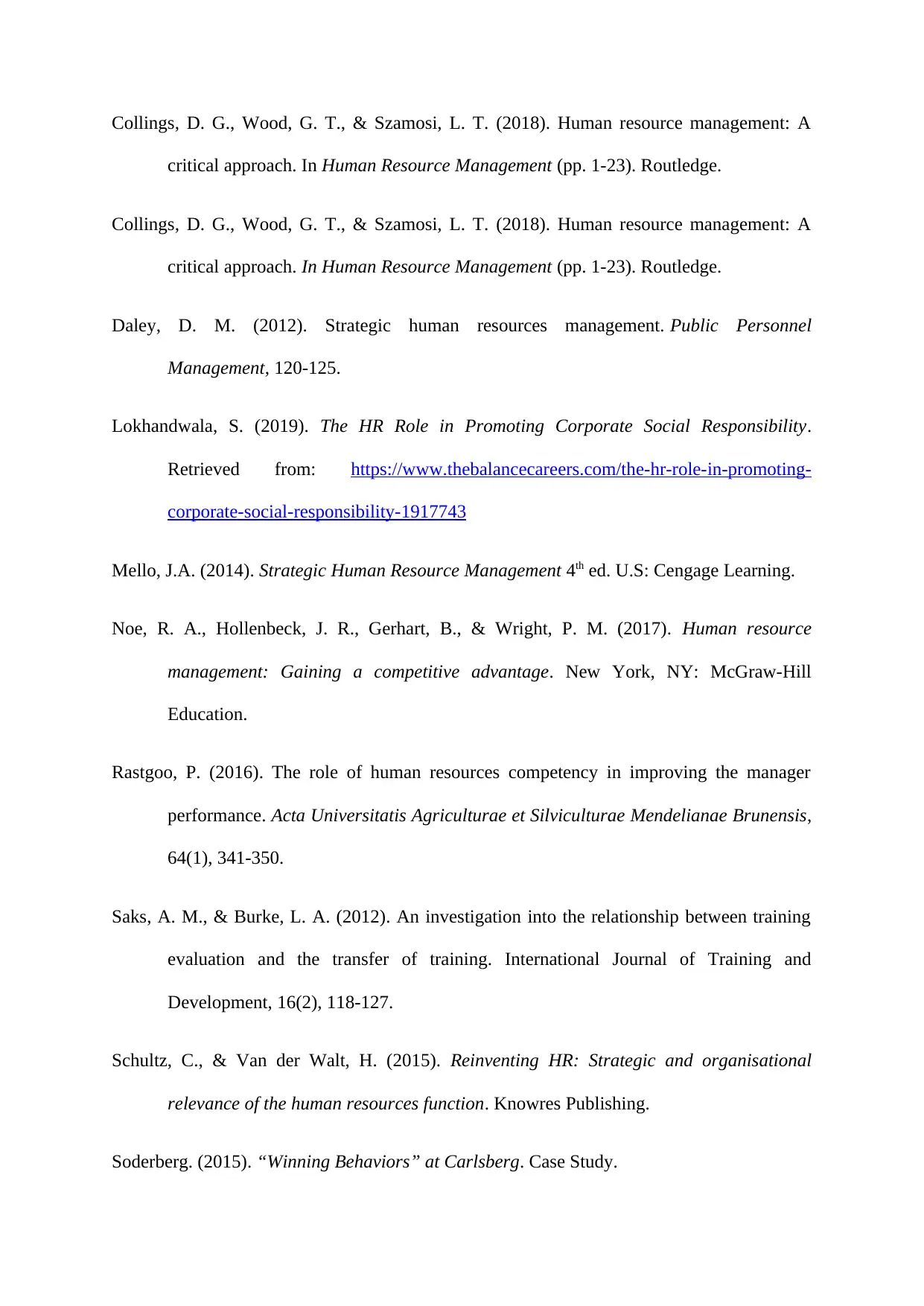
Collings, D. G., Wood, G. T., & Szamosi, L. T. (2018). Human resource management: A
critical approach. In Human Resource Management (pp. 1-23). Routledge.
Collings, D. G., Wood, G. T., & Szamosi, L. T. (2018). Human resource management: A
critical approach. In Human Resource Management (pp. 1-23). Routledge.
Daley, D. M. (2012). Strategic human resources management. Public Personnel
Management, 120-125.
Lokhandwala, S. (2019). The HR Role in Promoting Corporate Social Responsibility.
Retrieved from: https://www.thebalancecareers.com/the-hr-role-in-promoting-
corporate-social-responsibility-1917743
Mello, J.A. (2014). Strategic Human Resource Management 4th ed. U.S: Cengage Learning.
Noe, R. A., Hollenbeck, J. R., Gerhart, B., & Wright, P. M. (2017). Human resource
management: Gaining a competitive advantage. New York, NY: McGraw-Hill
Education.
Rastgoo, P. (2016). The role of human resources competency in improving the manager
performance. Acta Universitatis Agriculturae et Silviculturae Mendelianae Brunensis,
64(1), 341-350.
Saks, A. M., & Burke, L. A. (2012). An investigation into the relationship between training
evaluation and the transfer of training. International Journal of Training and
Development, 16(2), 118-127.
Schultz, C., & Van der Walt, H. (2015). Reinventing HR: Strategic and organisational
relevance of the human resources function. Knowres Publishing.
Soderberg. (2015). “Winning Behaviors” at Carlsberg. Case Study.
critical approach. In Human Resource Management (pp. 1-23). Routledge.
Collings, D. G., Wood, G. T., & Szamosi, L. T. (2018). Human resource management: A
critical approach. In Human Resource Management (pp. 1-23). Routledge.
Daley, D. M. (2012). Strategic human resources management. Public Personnel
Management, 120-125.
Lokhandwala, S. (2019). The HR Role in Promoting Corporate Social Responsibility.
Retrieved from: https://www.thebalancecareers.com/the-hr-role-in-promoting-
corporate-social-responsibility-1917743
Mello, J.A. (2014). Strategic Human Resource Management 4th ed. U.S: Cengage Learning.
Noe, R. A., Hollenbeck, J. R., Gerhart, B., & Wright, P. M. (2017). Human resource
management: Gaining a competitive advantage. New York, NY: McGraw-Hill
Education.
Rastgoo, P. (2016). The role of human resources competency in improving the manager
performance. Acta Universitatis Agriculturae et Silviculturae Mendelianae Brunensis,
64(1), 341-350.
Saks, A. M., & Burke, L. A. (2012). An investigation into the relationship between training
evaluation and the transfer of training. International Journal of Training and
Development, 16(2), 118-127.
Schultz, C., & Van der Walt, H. (2015). Reinventing HR: Strategic and organisational
relevance of the human resources function. Knowres Publishing.
Soderberg. (2015). “Winning Behaviors” at Carlsberg. Case Study.
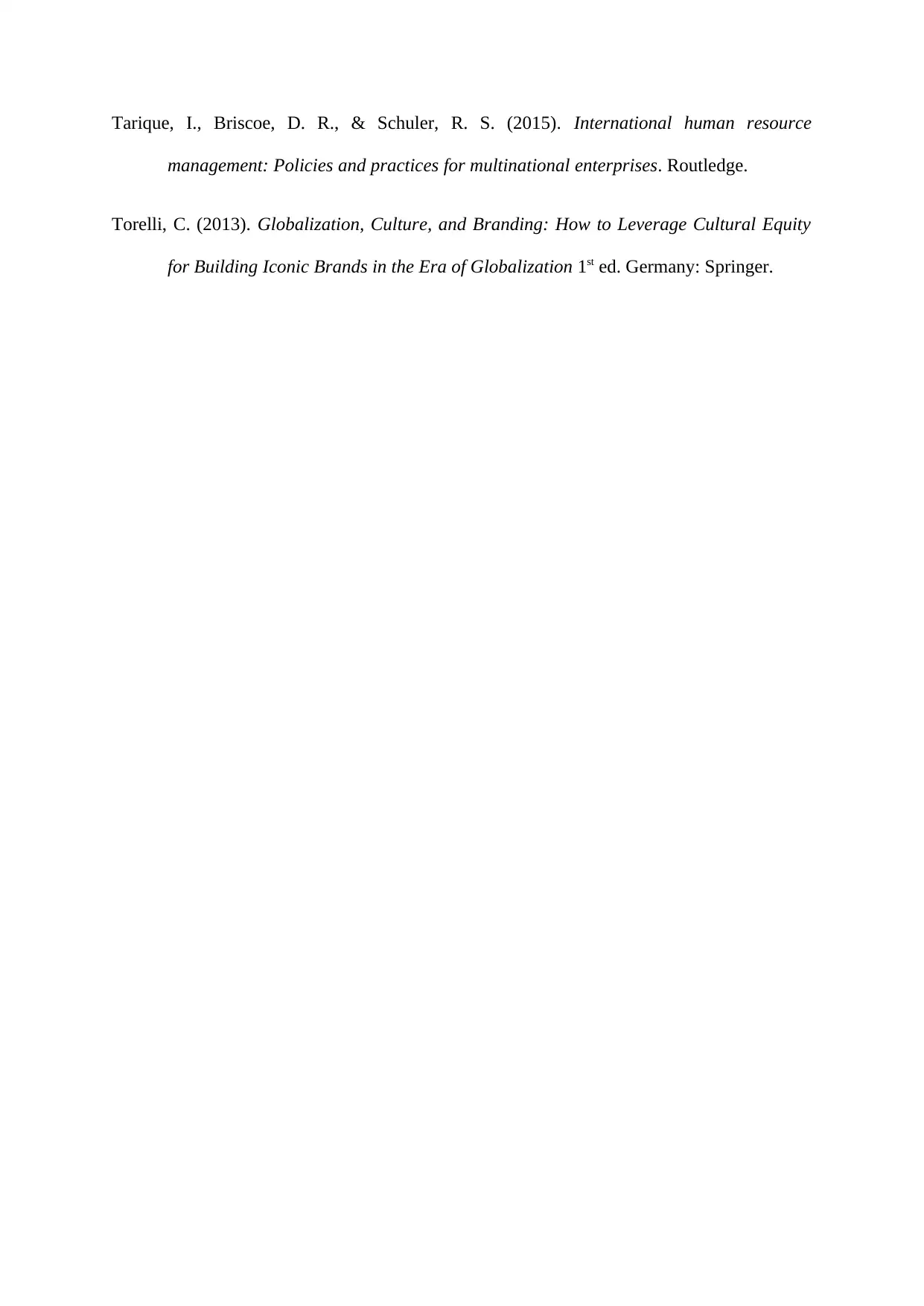
Tarique, I., Briscoe, D. R., & Schuler, R. S. (2015). International human resource
management: Policies and practices for multinational enterprises. Routledge.
Torelli, C. (2013). Globalization, Culture, and Branding: How to Leverage Cultural Equity
for Building Iconic Brands in the Era of Globalization 1st ed. Germany: Springer.
management: Policies and practices for multinational enterprises. Routledge.
Torelli, C. (2013). Globalization, Culture, and Branding: How to Leverage Cultural Equity
for Building Iconic Brands in the Era of Globalization 1st ed. Germany: Springer.
1 out of 13
Related Documents
Your All-in-One AI-Powered Toolkit for Academic Success.
+13062052269
info@desklib.com
Available 24*7 on WhatsApp / Email
![[object Object]](/_next/static/media/star-bottom.7253800d.svg)
Unlock your academic potential
© 2024 | Zucol Services PVT LTD | All rights reserved.





